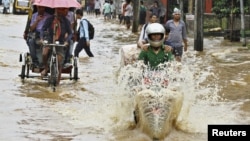NEW DELHI — Scant monsoon rains have raised concerns in India, one of the world’s biggest producers of food crops such as wheat, rice, and sugar. India’s farmers depend heavily on the annual rains to water their land.
The weather office says rains have been 30 percent below average in June over most parts of India.
As a result, the sowing of summer crops such as rice, cotton and sugar cane has been delayed in key food-producing regions of the country.
Meteorologists are holding out hope. They say rains this month could help bridge the shortfall.
But officials say contingency plans will be in place in case the monsoon does not pick up pace over the next two weeks.
“As of now there is no reason to believe that something adverse is happening, though I believe the agriculture ministry always takes precautionary steps,” said Montek Singh Ahluwalia, head of the Planning Commission.
Those precautions include drawing up plans to shift from crops such as rice and sugar that need abundant water to less thirsty ones such as beans and wheat.
The four-month June to September monsoon season is tracked closely because nearly 60 percent of the country’s farmland is dependent on rain.
India is the world’s second biggest producer of cotton, sugar, wheat and rice. It exports some of these crops, but also has a huge population to feed.
Economist D.H. Pai Panandiker heads the independent policy group RPG Goenka Foundation in New Delhi. He says concerns over the monsoon come at a critical time when the government is already battling high inflation and a slowing economy.
“Food inflation even now is something like 10 percent. If we have on top of that shortfall in agricultural production, I am sure that the food inflation will be pushed up further to about 15 percent or so,” Panandiker noted.
While consumers may be faced with higher prices, a deficient monsoon will not impact food security because bumper production of wheat and rice during the last two years means that India has adequate buffer stocks.
But prospects of a poor crop could prompt the government to limit exports. It could also lower rural incomes and hamper efforts to rev up economic growth.
While much of the country is parched, abundant rains in the north east have caused severe flooding in Assam, killing scores of people and displacing hundreds of thousands. Prime Minister Manmohan Singh visited the eastern state on Monday to extend the federal government’s support in relief and rehabilitation efforts.
”We will ensure adequate quantities of food grains and other essential commodities are available in the state and that agricultural seeds required for replacement purposes are also available,” stated Singh.
Although agriculture accounts for just 15 percent of the country’s economy, it is crucial because nearly two thirds of the country’s one-point-two billion people depend on the sector for their livelihood.
The weather office says rains have been 30 percent below average in June over most parts of India.
As a result, the sowing of summer crops such as rice, cotton and sugar cane has been delayed in key food-producing regions of the country.
Meteorologists are holding out hope. They say rains this month could help bridge the shortfall.
But officials say contingency plans will be in place in case the monsoon does not pick up pace over the next two weeks.
“As of now there is no reason to believe that something adverse is happening, though I believe the agriculture ministry always takes precautionary steps,” said Montek Singh Ahluwalia, head of the Planning Commission.
Those precautions include drawing up plans to shift from crops such as rice and sugar that need abundant water to less thirsty ones such as beans and wheat.
The four-month June to September monsoon season is tracked closely because nearly 60 percent of the country’s farmland is dependent on rain.
India is the world’s second biggest producer of cotton, sugar, wheat and rice. It exports some of these crops, but also has a huge population to feed.
Economist D.H. Pai Panandiker heads the independent policy group RPG Goenka Foundation in New Delhi. He says concerns over the monsoon come at a critical time when the government is already battling high inflation and a slowing economy.
“Food inflation even now is something like 10 percent. If we have on top of that shortfall in agricultural production, I am sure that the food inflation will be pushed up further to about 15 percent or so,” Panandiker noted.
While consumers may be faced with higher prices, a deficient monsoon will not impact food security because bumper production of wheat and rice during the last two years means that India has adequate buffer stocks.
But prospects of a poor crop could prompt the government to limit exports. It could also lower rural incomes and hamper efforts to rev up economic growth.
While much of the country is parched, abundant rains in the north east have caused severe flooding in Assam, killing scores of people and displacing hundreds of thousands. Prime Minister Manmohan Singh visited the eastern state on Monday to extend the federal government’s support in relief and rehabilitation efforts.
”We will ensure adequate quantities of food grains and other essential commodities are available in the state and that agricultural seeds required for replacement purposes are also available,” stated Singh.
Although agriculture accounts for just 15 percent of the country’s economy, it is crucial because nearly two thirds of the country’s one-point-two billion people depend on the sector for their livelihood.







